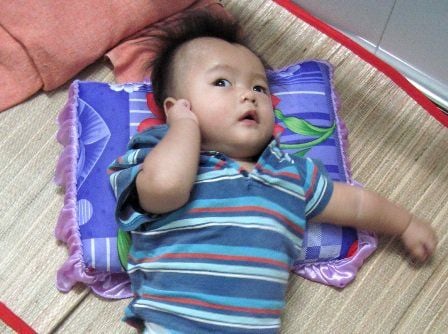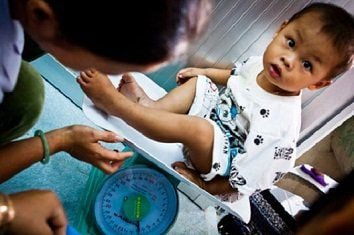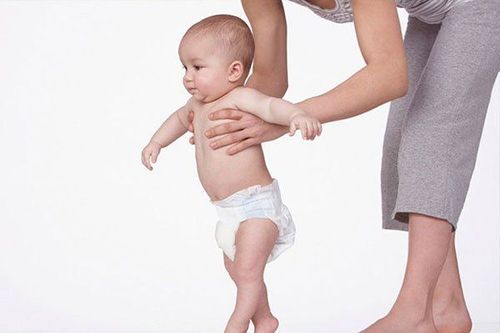This is an automatically translated article.
The article was professionally consulted by Specialist Doctor II Le Thanh Cam - Department of Pediatrics - Neonatology - Vinmec Danang International General Hospital. Uncle has 15 years of experience in diagnosis & treatment of pediatric diseases; She used to work at the Pediatric Department - Da Nang Hospital and Da Nang Center for Obstetrics and Gynecology. Her strength is diagnosis and treatment of pediatric diseases; resuscitation, pediatric emergency.The main rule to identify a toddler is time. By 18 months old, the average age of a child can walk, if at this age the child cannot walk, it is called slow. So what should children do?
1. How to teach children who are slow to walk
There are many ways to promote the baby to walk on time, such as nutritional intervention, use of supportive drugs to supplement micronutrients and mineral salts... However, it is necessary to determine the cause of the delay. and find a way to fix it. Here are some ways to teach children who are slow to walk due to lack of movement.Hands and feet for children: Regularly perform foot and hand movements for babies. When stretching, the limbs are stretched out, parents or relatives can both massage and talk to the baby, making the baby feel comfortable, learning language and useful for the baby's movements. The manipulation of limbs will help increase blood flow to the muscles and increase the reflexes of the tendons and bones. One of the ways to teach children who are slow to walk is by manipulating their hands and feet, which is to stimulate the baby's legs, which is a continuous stretch, similar to the movement of "pedaling a cyclo". The effect of stretching limbs is to increase leg muscle mass and contraction strength of the legs. Parents should perform stretching movements from 3 to 5 times a day and massage from thighs to feet and from armpits to hands, then can let the baby stretch.
Trắc nghiệm: Sự phát triển tinh thần, vận động của bé thế nào là đúng chuẩn?
Khi nào bé biết nói, biết hóng chuyện hay biết cầm cốc là "đúng chuẩn"? Điểm xem bạn biết được bao nhiêu mốc phát triển tinh thần, vận động "đúng chuẩn" của bé nhé!The following content is prepared under supervision of Thạc sĩ, Bác sĩ y khoa, Ma Văn Thấm , Nhi , Phòng khám Đa khoa Quốc tế Vinmec Dương Đông(Phú Quốc)
Stimulating children to move: How to teach children who are slow to walk by putting toys out of reach of children, will stimulate children's movement. Parents need to use toys that children love, which can also be simple items, such as cups and spoons, which are toys that children love very much. Your baby can hold a spoon to suck and chew on the cup, or use a spoon to knock on the cup to make a sound. If possible, parents should choose toys and items made of wood to ensure safety for children, because they do not break and do not cause injury. Initially, parents should bring the baby to a wide floor, then put the toys out of reach of the baby. To get the toy that the baby likes, the baby has to reach, crawl, and crawl. That's how to teach slow children to walk. However, parents should not leave the toy too far away, which will discourage the baby. Each time the baby touches the toy, parents can move the toy a little further away, repeat about 2-3 times, then let the baby touch once to make the baby interested, avoid letting the baby not touch it. discouragement and giving up.

Create a space for your baby to learn to walk: If possible, arrange an area large enough and safe for the baby to learn to walk. For children to learn to walk, there must be space for them to crawl and move. With this way of teaching slow children to walk, parents can arrange more supports for their children such as chairs, tables or bed rails, handrails on the wall, however, it is necessary to ensure the safety of the baby and have a stimulating effect. I like baby learning to walk. At that time, the baby will be more confident in learning to walk, especially those who are a bit shy. Support the baby: Parents need to stimulate and support the baby to help the baby learn to walk. Support means that when the baby tries to practice a certain movement, the parents can support to help the child perform successfully and make the baby find movement very interesting. Support in the way to teach children who are slow to walk also helps them not to panic when they learn to crawl, learn to stand or learn to walk. With learning to walk, when the baby is standing, parents can slightly lift the baby's armpits so that the baby feels safe and takes the legs to learn to walk. Just like that, the baby is practiced every day, he will find it interesting and gradually like to do more difficult movements next time. Along with supporting, the way to teach children who is slow to walk is that parents also need to stimulate them by guiding them, taking the initiative for them to get used to the movements they have never done before so that they can feel like and want. perform those actions. For example, when a baby starts to learn to stand, parents can lift him up so he can stand. At that time, the baby will find standing very interesting and not scary. For the baby to learn to walk, parents can hold the baby's armpit and go with the baby so that the baby feels that walking is fun and safe. However, with how to teach a slow child to walk, when learning to walk, the baby's neck needs to be stiff and the back must be straight. In the early stages of learning to walk, parents need to be near the baby, let the baby learn to walk about 1-2 steps by trying to release the hand, and let the baby fall into the parent's lap. At that time, the baby's muscle strength will increase very quickly. Parents also need to encourage the baby by praising and hugging the baby. Just like that, the baby learns to walk day by day and the time will come when he will be able to walk on his own. Keep your child near other children of the same age: Putting your child close to other children with similar or better motor abilities will attract and stimulate the child to follow. This is also one of the ways to teach children who are slow to walk, however, it is necessary to avoid putting children in the group of movement differences because it may not have a stimulating effect on children. The downside of this measure can be that the child can be infected from another child if that child is sick, but it has a very positive effect.
2. Rehabilitation for children who are slow to walk due to cerebral palsy

One of the other causes of slow walking in children is cerebral palsy. At this time, children need rehabilitation intervention. Here are some techniques to help your child learn to stand and walk:
Rehabilitation by facilitating standing in a standing desk: Place child prone on a standing desk, feet wider than shoulder width, using a restraint belt in the child's knees, groin, and chest. Then, lean the table against the edge of the table and place a few toys on the table to encourage the child to reach forward or to the sides for the toy. Rehabilitation by facilitating standing between two fixed poles: Place the child between the two poles, feet wider than shoulder width, using a harness to secure the child's knees, groin, and chest. Place toys on the table to encourage your child to reach forward or to the sides for the toy. Rehabilitation by making it easier to place weight on each leg: Place the child on the wall, feet wider than shoulder width. Instruct the child to lift one leg up so the weight is on the other, support the child's hips when needed, repeat with the other leg by switching sides. Rehabilitation by learning to walk in parallel bars: Place the child standing holding onto two parallel bars, feet wider than shoulder width. Instruct the child to raise one leg so that the weight is on the other foot when walking, supporting the child's hips when needed. Rehabilitation by walking with a walker: Place the child standing with both hands on the handle of the walker, feet wider than shoulder width. Instruct the child to raise one leg so that the weight is on the other foot when walking, supporting the child's hips when needed. When children slow down what to do, parents should not be too worried, instead need to determine the cause of the child's slowing down and find ways to overcome that cause. In addition, parents should also apply some methods to change habits and improve nutrition to support the child's teeth to develop better.
Besides, parents also need to supplement their children with essential micro-minerals such as zinc, lysine, chromium, selenium, vitamin B1, ... to fully meet the nutritional needs of children. The addition of these essential vitamins also supports digestion, enhances nutrient absorption, improves anorexia, and helps children eat well. Parents can simultaneously apply dietary supplements and functional foods derived from nature for easy absorption. The most important thing is that improving your baby's symptoms often takes a long time. Combining many types of functional foods at the same time or changing many types in a short time can make the baby's digestive system unable to adapt and completely not good. Therefore, parents must be really patient with their children and regularly visit the website vimec.com to update useful baby care information.















